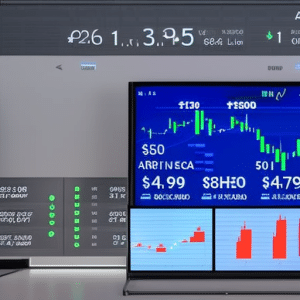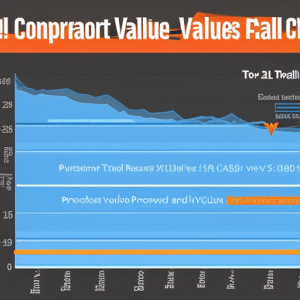Ethereum is a decentralized platform for applications that run exactly as programmed without any chance of fraud, censorship or third-party interference. It has become the most popular cryptocurrency in the world and it has experienced extreme price volatility in recent years. Although this can seem daunting to some investors, it also presents an opportunity to make large profits in a short span of time. This article will investigate the factors influencing Ethereum’s price volatility and discuss strategies for mitigating risk and taking advantage of market movements.
Key Takeaways
- Factors influencing Ethereum’s price volatility include news events, technological advancements, market speculation, and changes in market sentiment.
- Regulatory environment and media coverage can significantly impact the value of Ethereum.
- Price volatility can impact individual investors and the cryptocurrency market as a whole, affecting mining activities and liquidity.
- Hedging strategies, such as using derivatives like futures contracts and options trading, can help investors mitigate risk and benefit from price volatility.
Overview of Ethereum
Ethereum is an open-source, public, blockchain-based distributed computing platform and operating system featuring smart contract functionality, which has seen notable volatility in its price. Ethereum enables users to build decentralized applications (dApps) that run on the Ethereum blockchain. The use of smart contracts allows for faster and more secure transactions compared to traditional methods. These features have helped make Ethereum one of the most popular cryptocurrencies in use today. Additionally, dApps can be built on top of the Ethereum network, allowing developers to create new applications that are secured by cryptography and utilize the underlying blockchain technology.
The volatility of Ethereum’s price is influenced by a number of factors such as news events related to cryptocurrency regulation, technological advancements, and market speculation. With these factors playing a major role in determining the direction of Ethereum’s price movements, investors must be aware of how they may affect their investments before taking action. Moving forward, understanding and staying informed about these factors will be key for any investor looking to capitalize on fluctuations in the value of Ether.
Factors Influencing Ethereum Price Volatility
Ethereum price volatility is an important factor that affects the cryptocurrency market. In order to better understand this phenomenon, it is important to examine the various factors that influence Ethereum’s price movements. These include supply and demand, market sentiment, regulatory environment, media coverage, and speculation. Supply and demand affects the availability of Ethereum tokens which can lead to large fluctuations in prices. Market sentiment reflects investor confidence or lack thereof in cryptocurrencies as a whole or in particular tokens such as Ethereum. Regulatory environment refers to regulations affecting the use of cryptocurrencies which can impact their value significantly. Media coverage often creates hype around certain digital assets like Etherum leading to increased trading activity and speculative investments. Finally, speculation by investors has been known to create considerable volatility in Ethereum prices both up and down.
Supply and Demand
The supply and demand of Ethereum can have a large influence on its price volatility. Supply sources for Ethereum are comprised of mining activities, which involve the use of computing power to solve cryptographic equations that verify transactions on the blockchain network. These miners receive rewards in Ether tokens as compensation for their work, which increases the total circulating supply and affects price movements. On the other side of the equation is demand dynamics, which are driven by speculation from investors who buy and sell digital currency based on their sentiment about market conditions. Market makers also have an influence by trading large amounts of Ether in order to maintain liquidity within the market. As such, any shifts in these two forces can create significant fluctuations in prices.
Changes in market sentiment is another factor that plays a role in Ethereum price volatility. Generally speaking, when more people believe that Ethereum will increase in value over time, they are more likely to invest and this causes prices to rise as a result of increased demand. Conversely, when there is bearish sentiment about the future performance of the asset class prices may decrease due to selling pressure coming from investors attempting to minimize losses or take profits from previous gains. As such, it’s important for traders and investors to stay up-to-date with news related to Ethereum so they can make informed decisions about their investments and manage risk accordingly.
Market Sentiment
Market sentiment plays a significant role in influencing the price movements of Ethereum, with bullish sentiment typically leading to increased demand and higher prices, while bearish sentiment can lead to lowered demand and decreased prices. According to one survey, 83% of investors are optimistic about the future of Ethereum. This strong positive sentiment is likely attributed to advances in blockchain technology, such as the development of smart contracts on Ethereum’s platform, which has made it an attractive option for many investors. Sentiment tracking tools have been developed to measure investor psychology and identify potential changes in market trends. These metrics provide insight into how traders and investors view Ethereum’s potential and help inform decisions regarding buying or selling activity. As regulatory environments around cryptocurrency continue to evolve, understanding these changes will be essential for predicting short-term price volatility.
Regulatory Environment
Regulatory developments in the cryptocurrency space have been a major factor in influencing investor sentiment and determining Ethereum’s price movements. Technological advancements such as blockchain technology, which is the backbone of Ethereum, present both opportunities and challenges for regulators because it can be used to bypass traditional financial systems. This has led to regulatory uncertainty and investor unease about how digital assets are classified or regulated. Additionally, governments around the world have released differing approaches to regulating cryptocurrencies, creating an atmosphere of flux and unpredictability that further fuels investor anxiety. This has resulted in increased price volatility for Ethereum due to the uncertain regulatory environment.
The media coverage surrounding cryptocurrency has also been influential on Ethereum’s price fluctuations. Reports from news outlets can often create an atmosphere of fear or excitement about Ethereum depending on their tone or content, leading investors to buy or sell out of panic or enthusiasm respectively. Furthermore, rumors circulating through social media channels have had a similar effect on prices as they allow information to spread quickly and cause wild fluctuations in investor confidence that can result in extreme volatility in prices. As such, the combination of uncertain regulation and media coverage has created a heightened level of volatility for Ethereum prices that must be accounted for when considering investing decisions. Moving forward, it will be important to pay attention to both the regulatory environment and media coverage for more accurate insight into potential future pricing trends.
Media Coverage
Media coverage surrounding cryptocurrencies has been a major factor in influencing investor sentiment and affecting price movements. Ethereum is no exception, with the media playing an important role in both its success and volatility. Specifically, reports of hacks on cryptocurrency exchanges or changes to mining difficulty can heavily influence the public perception of Ethereum’s value, prompting investors to either buy more or sell their holdings. As a result, public opinion can easily drive prices up or down with relatively little effort from traders themselves. This highlights the importance of staying abreast of news related to Ethereum and other cryptocurrencies as it can have a significant effect on price movements. In addition, speculation about future developments within the industry can also lead to significant price fluctuations due to its potential impact on market sentiment.
Speculation
Speculation regarding the future of cryptocurrencies can lead to a roller-coaster ride of emotions, as investors attempt to guess the direction of the market. For Ethereum in particular, speculation strategies used by investors and traders alike are often based on risk analysis, which entails assessing factors such as project fundamentals and technical indicators. These strategies help investors determine whether or not they should buy Ethereum at a certain price point or exit their position after making profits from price volatility. Such speculation has become increasingly popular among cryptocurrency traders who use it to capitalize on short-term gains. By gauging their risk tolerance and understanding market trends through active research, speculators can gain a better sense of when is the right time to enter or exit an investment in Ethereum. As such, speculation plays an important role in influencing Ethereum’s price volatility. Moving forward, it is important for users to understand both speculative strategies and underlying risks associated with them before investing in Ethereum.
Effects of Price Volatility
Price volatility of Ethereum can have a significant impact on individual investors and the cryptocurrency market as a whole. Crypto mining, which is powered by blockchain technology, has become more popular due to its decentralization and potential for high rewards. Price volatility can cause an increase in mining difficulty which could lead to miners being unable to cover their electricity costs or other overhead associated with crypto mining. This could result in miners selling off their holdings at a loss if prices fall below the cost of production, leading to further downward pressure on the price of Ethereum. On the other hand, if prices rise substantially then this could create an environment where fewer new miners are entering the market due to decreased incentives. This could lead to decreased liquidity and increased volatility as there are fewer participants within the ecosystem. To mitigate these risks it is important for investors and users of Ethereum to closely monitor developments in terms of both price movements and advances in blockchain technology itself.
How to Mitigate Risk
Investors and users of cryptocurrencies should consider strategies to reduce their risk exposure due to the potential for high volatility. One way to do this is through hedging strategies, which can involve using derivatives such as futures contracts. Futures allow traders to set up a contract that locks in a price at some point in the future, allowing investors to protect against losses from price declines. Stop loss orders are also useful for reducing risks by setting an automatic sell trigger at a predetermined price level in order to avoid large losses. Another technique involves diversifying investments among different coins or tokens, so that any single asset’s decline does not have such an outsized effect on overall portfolio performance.
These techniques are all important tools for mitigating volatility-related risks associated with Ethereum investing and trading, but they must be used carefully since their effectiveness depends upon market conditions and other factors like liquidity. By taking advantage of these strategies responsibly, it is possible to reduce risk exposure while still participating in the cryptocurrency markets. This transition provides a strong foundation for exploring Ethereum futures trading as another option available for managing risk exposure.
Ethereum Futures Trading
The use of futures contract trading can be used as a way to mitigate risk associated with the volatility of Ethereum prices. Hedge funds and institutional investors may choose to enter into these contracts in order to limit exposure to liquidity risk, while simultaneously taking advantage of potential price movements. This is especially valuable for those who are unable to access the spot market due to its high volatility and low liquidity. Futures contracts are beneficial as they provide traders with the ability to hedge their positions and create greater market efficiency.
However, in order for futures trading strategies on Ethereum’s price volatility to be successful, it is important that there is sufficient liquidity available in the markets. Without adequate liquidity, traders may have difficulty entering or exiting trades at an advantageous price point, resulting in losses or missed opportunities for profit. As such, it is important that traders consider all aspects before engaging in futures trading on Ethereum’s price volatility and take steps to ensure adequate liquidity exists within the marketplace. With this considered, investors can then proceed with confidence towards further exploring options trading strategies as a means of mitigating risks associated with Ethereum’s volatile prices.
Ethereum Options Trading
By utilizing options trading strategies, market participants can seek to capitalize on potential changes in the underlying asset’s value without directly purchasing or selling the asset. Ethereum options trading has become increasingly popular as institutional demand for cryptocurrency-based derivatives rises, offering traders a way to hedge against volatility and liquidity risk. Options contracts are typically more complex than futures contracts and require a deeper understanding of how they work, but with increasing institutional involvement there is growing liquidity in the Ethereum options markets which helps reduce risk for investors. As such, Ethereum options trading can be seen as another way for traders to take advantage of price movements without having to go through the hassle of buying and selling Ether itself. In conclusion, while not suitable for everyone due to its complexity compared to other derivative products, Ethereum options trading offers an attractive alternative to those looking to gain exposure to potential price movement in the ETH/USD pair. Transitioning into discussing Ethereum derivatives trading will provide further insight into this topic.
Ethereum Derivatives Trading
Eagerly seizing opportunities, traders have recently paid increasing attention to Ethereum derivatives trading as a way to benefit from fluctuations in digital asset values. Derivatives are a type of financial instrument that enables investors to hedge risks or speculate on the future direction of prices. Ethereum options and futures contracts are two of the most popular types of derivative instruments on the market that allow investors to take advantage of price volatility for profit.
Hedge strategies such as buying call option contracts can protect traders against losses due to downward price movements while arbitrage trading provides an opportunity for quick profits by taking advantage of differences in prices between exchanges. It is important for traders to understand the features and risks associated with these instruments before engaging in derivative trading activities. Additionally, automated trading has become increasingly popular among traders who seek more efficient execution and improved profitability with lower transaction costs.
The Role of Automated Trading
Automated trading has become increasingly popular as a way to seek improved profitability and efficient execution with lower transaction costs. With decentralized exchanges and algorithmic strategies, market participants are able to engage in automated trading without using centralized brokers or financial advisors. This technology allows traders to execute trades swiftly and consistently without fear of human error. Automated trading can be particularly advantageous in the volatile crypto markets, as it enables traders to react quickly to price movements and capitalize on short-term gains while mitigating risk through diversification. However, security considerations must also be taken into account when engaging in automated trading on Ethereum’s networks.
Security Considerations
Due to the prevalence of malicious actors in the crypto sphere, security considerations are paramount when engaging in automated trading. Recent studies have found that over 5 million dollars worth of Ethereum-based assets were stolen during 2020 alone, highlighting the importance of protecting funds at all times. In addition to theft, there is also a risk of money laundering and cryptocurrency fraud which further necessitates proper security protocols be taken into account.
To secure funds from these potential threats, traders must ensure that they are using reliable exchanges with stringent security measures as well as multi-factor authentication for added protection. Furthermore, it is important to keep private keys off online systems and always make use of cold storage methods such as hardware wallets or paper wallets. By taking these steps one can minimize the risks associated with automated Ethereum trading and ensure their investments remain safe. These methods provide an overall heightened level of security which helps reduce volatility in prices due to malicious actors attempting to manipulate markets and provides a more stable environment for investors seeking long-term returns. Transitioning now into the next section about ‘tax implications’
Tax Implications
The taxation of automated Ethereum trading is an important factor to consider when engaging in such activities. Crypto taxes are becoming increasingly more complex as governments around the world attempt to regulate cryptocurrency markets. Price speculation has become a popular way for investors to make money in the volatile crypto markets, and tax regulations have had to adapt accordingly. While some countries levy taxes on capital gains when investing or trading cryptocurrencies, others do not yet have any specific rules or laws for cryptocurrencies that deal with taxation. It is therefore important for Ethereum traders to be aware of their local tax laws before beginning any automated trading activity.
In the case of Ethereum price volatility, taxes must also be taken into account when making decisions about investments and trades. This can involve understanding existing regulations as well as anticipating new ones that may come into effect in the future. Additionally, traders should also take into account how different strategies will affect their tax liabilities and ensure they are always compliant with applicable laws and regulations. With so many factors at play, it is essential for Ethereum traders to stay informed about potential tax implications before engaging in automated trading activities involving this cryptocurrency.
Final Thoughts
Navigating the taxation of automated crypto trading can be a complex endeavor, but it is essential for investors to stay informed and compliant with applicable laws. When considering the implications of Ethereum price volatility, there are several risk management techniques that investors should consider. A sound trading strategy involves recognizing the impact of market fundamentals on prices and utilizing hedging strategies to reduce portfolio risk exposure. Additionally, the ability to recognize trends in price movements and make informed decisions can help protect against downside risks associated with cryptocurrency investments.
In order to effectively manage risk associated with Ethereum price volatility, traders must remain aware of news events that could affect prices and build a robust trading strategy which takes into account various market conditions. Utilizing tools such as stop-loss orders and limit orders can also help investors manage their exposure to volatility while still taking advantage of potential opportunities presented by changes in the market. Ultimately, understanding how Ethereum price fluctuations affect portfolios is key to successful investing in this dynamic digital asset class.
Frequently Asked Questions
What is the best way to buy Ethereum?
The best way to buy Ethereum depends on individual buying strategies and preferences. Decentralized exchanges provide an efficient solution for those who value privacy and security. Other options include cryptocurrency exchanges, peer-to-peer trading, and direct purchase from a broker or vendor. Careful research is essential to ensure the best choice for each situation.
What is the difference between Ethereum Futures Trading and Ethereum Options Trading?
Imagery of two ships buffeted by a stormy sea; one with sails furled to hedge against the tempest, the other, its course unchanging. Ethereum futures trading allows investors to protect their investments from volatility through hedging strategies, while options trading enables them to speculate on market movements. Both are powerful tools for managing risk.
How does Automated Trading factor into Ethereum price volatility?
Smart contracts and algorithmic trading, also known as automated trading, can have a major influence on the volatility of Ethereum prices. Automated trading allows for fast and efficient order execution which can cause price movements to be more abrupt and unpredictable.
Is there a way to predict Ethereum price movements?
It is possible to attempt to predict Ethereum price movements through the use of either technical or fundamental analysis. Technical analysis involves studying historical price charts while fundamental analysis involves researching various factors which may influence the asset’s value. Both can be utilized to gain insight into potential future price movements.
What is the most secure way to store Ethereum?
The most secure way to store Ethereum is to use a hardware wallet, such as a Ledger Nano S. This type of wallet provides increased security when buying and securing coins by providing an offline storage solution for cryptocurrency assets. Additionally, it is important to only purchase Ethereum from reliable sources in order to ensure the safety of funds.







